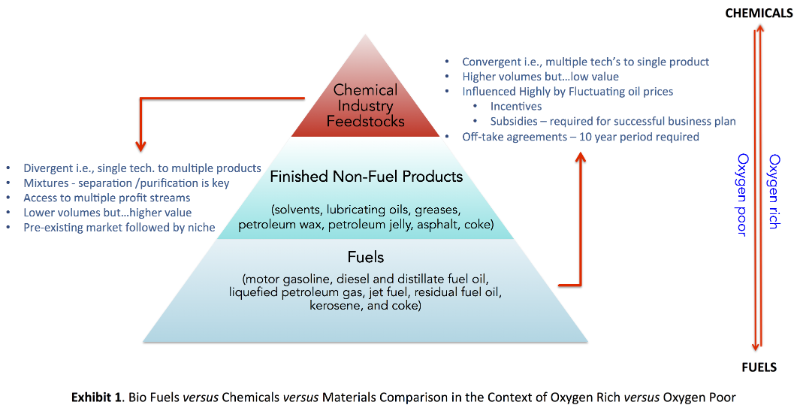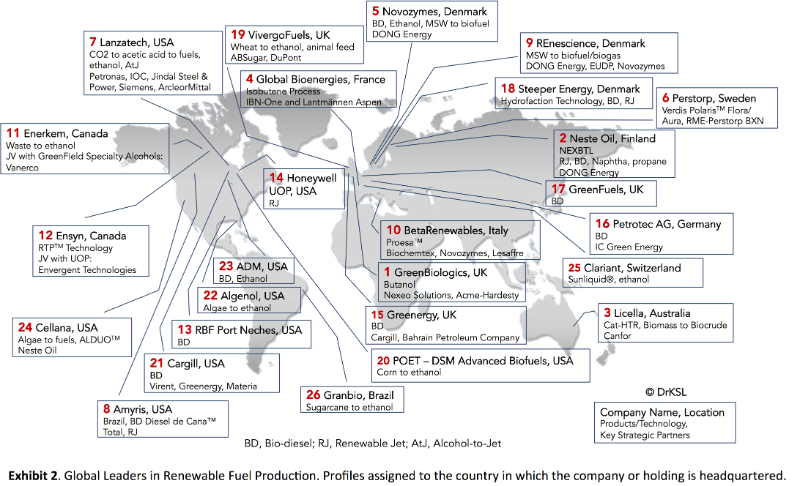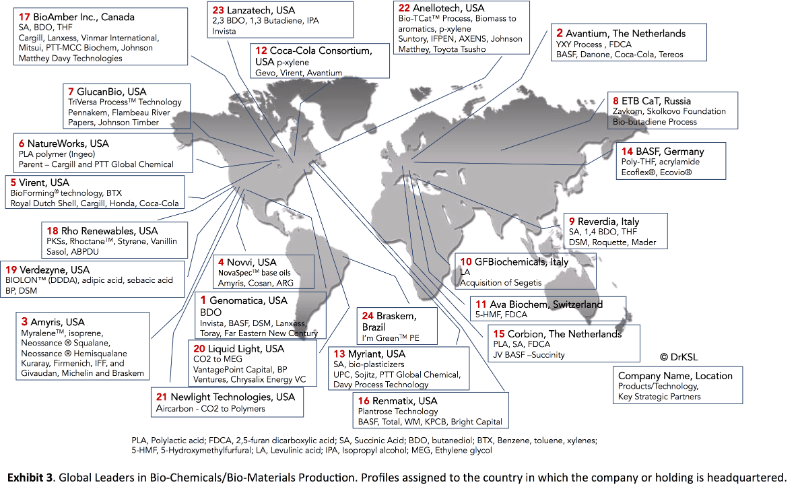50 Hot Bio-Based Companies, 50 Quick Takes
Which goals and projects should be considered top-priority in the coming years besides solar, wind and hydro-based companies in regards to upgrading biomass?
Renewables are coming to replace petroleum, predicted by self-proclaimed tech prognosticators everywhere.
On the other end — inflated and unrealistic valuations, a shaky stock market, and a weak China, and as the oil prices fluctuate, they will take many smaller and un-mythical bio-based startups down. Why? Because you cannot have a successful bio-based company without a subsidy or an incentive from the government with the era of $44 crude oil! That is the usual reply from the unfamiliar!
What is real is, the global population has more than doubled in the past 50 years. As of March 2016, the world population was estimated at 7.4 billion, an all-time record high. The United Nations estimates it will further increase to 11.2 billion in 2100. Subsequently, with this increase has the demand for, and consumption of, energy increased as lifestyle requirements have gone up.
Over this period of rapid growth, the proportion of that consumed energy attributed to fossil fuel has remained fairly steady, falling marginally about 10-12 percent. A portion of that slight drop is due to a fall in global coal consumption. The first oil price shocks in the 1970s were the trigger for the start of intensive R&D associated with what are today’s renewables: solar, wind, hydro power, together with the range of cultivated biofuels from grasses to algae to municipal waste.
Whilst at a slower pace, renewable (bio-, solar, hydro, wind) fuels provide a reasonable chunk of the energy we use today, and that is in spite of the increasing rhetoric from the fossil industry.
In the conceptual design of the future — towards a sustainable society — often there is a high degree of disengagement with what matters most within the industry and more importantly lack societal needs. Finding an alternative for a 100-plus-year old petroleum industry is not just trivial but a Herculean undertaking. The three obvious pathways to the creation of a sustainable future are via an integrated approach:
- Carbon capture and storage — to mitigate emissions from existing infrastructure, such as the ubiquitous iron and steel, cement and chemical industries, along with the aviation, automotive and marine industry, etc., to minimize impacts of continued global warming,
- Utilize solar, wind and hydro towards CO2 mitigation and electricity generation to address local transportation requirements, and
- Focus on a bio-based industry for novel approaches to transportation fuels (heavy trucks, marine, and aviation fuels, etc.), but also supplement the chemical requirements (fundamental chemical building blocks, chemical precursors, solvents, lubricants etc.). (See Exhibit 1.)

For those unfamiliar, an approximate estimation of terrestrial biomass growth amounts to 118 billion tons/year, dried. About 14 billion tons of biomass/year are produced in agricultural cycles, and of this nearly 12 billion tons/year are essentially discharged as waste. Obviously, there is enough biomass available at potentially low cost to be used in many different ways (upgrading available biomass itself, extracting valuable components, etc.) and many companies have capitalized on various aspects that will be described below on the map. (See Exhibits 2 and 3.)
The ubiquitous oil industry whilst reluctantly, has now realized that renewables are poised to seize the crucial top spot in global energy supply, for example, the Recent Outlook to 2035 by BP and The Outlook for Energy: A View to 2040 by Exxon Mobil discuss the predicted distribution within the industry.

This reality hardly leaves time for complacency for those in the renewable sector. In simple words, which goals and projects should be considered top-priority in the coming years besides solar, wind and hydro-based companies in regards to upgrading biomass? The top 50 companies are picked based on a few primary industries, i.e., fuels (ethanol, butanol, diesel, renewable jet, marine fuels, CO2 remediation), and chemical-based companies.
In addition, whilst a detailed study is available for many of these companies in the March edition of Biofuels Digest — a new list is provided for the readers based on feedback from some of the top minds in the industry. In addition, in the wrap-up, I will pick 5 “Hot off the Griddle” contributors to the field that have the potential for capturing the right markets while disrupting existing value chains, namely Green Biologics, Novvi LLC, Licella, Genomatica, and Avantium.
Top 5 Hot off the Griddle
1. Green Biologics
Founded by Dr. Edward Green in Oxford, England, Green Biologics Ltd is a renewable fuels/chemicals company focussed on developing and delivering bio-butanol with its technology platform built on Clostridium microbial fermentation. Following its merger in 2012 with Butylfuel Inc., and acquiring the assets of Central MN Ethanol Co-op LLC in Little Falls, Minn., in 2014, Green Biologics is repurposing a 21-million-gallon per year ethanol plant to produce normal butanol and acetone, in 2016. With distribution agreements earlier this year with Texas-based Nexeo Solutions and Acme-Hardesty, a division of Jacob Stern & Sons Inc. and leading supplier of bio-based chemicals, Green Biologics is one company which has managed to keep a level head — as opposed to the “other” isobutanol company, which has failed on multiple occasions — giving Green Biologics a well-deserved No. 1 spot on the Hot off the Griddle list.
2. Novvi
Novvi LLC is a joint venture between successful global leader Amyris, Inc. and Cosan S.A. Industria e Comercio created to develop, produce, market, and distribute high-performance oils and lubricants from renewable sources. Novvi draws from the strength of both companies — Amyris’ with its synthetic biology platform to produce targeted hydrocarbon molecules from plant sugar and Cosan’s feedstock capabilities, supply and distribution infrastructure. With the most recent, one-third partner American Refining Group, Novvi has definitely made news splash across the industry.
3. Licella
Licella uses the Cat-HTR platform to convert a variety of low-cost, non-edible biomass into stable biocrude oil, which can be refined, in a conventional refinery, into next generation biofuels and biochemicals. Operating over the past eight years, Licella has invested AUD$60 million in its technology development, conservatively yet progressively scaling up its Cat-HTR platform to its current Gen-3 version. Licella is a subsidiary of Licella Pty. Limited, which in turn is a subsidiary of Ignite Energy Resources Ltd. (IER), an Australian public unlisted natural resource and energy technology development company. IER has developed a proprietary lignite and biomass-upgrading platform, the Catalytic Hydrothermal Reactor (Cat-HTR). IER operates via three subsidiaries, Ignite Resources Pty. Ltd. (applying Cat-HTR to lignite), Licella Pty. Ltd. (applying Cat-HTR to biomass), and Gippsland Gas Pty. Ltd. (biogenic natural gas resource). With a past collaborative effort with Norske Skog and the latest with Canadian Canfor in 2016 — Licella has one technology that has a huge hidden potential that needs the right investments to flourish.
4. Genomatica
A widely recognized bioengineering technology leader within the bio-chemical industry, Genomatica, with its GENO BDO process, has produced tons of BDO and gained recognition from BASF, Novamont — license, and Cargill — production support. The BDO produced continues to extend further into product value chains, with validation from firms including Invista (Lycra spandex), BASF (PolyTHF), DSM, Lanxess, Toray, and Far Eastern New Century. With partners including Versalis and Braskem, Genomatica has managed to raise over $125 million in financing from Alloy Ventures, Bright Capital, Cargill, Draper Fisher Jurvetson, Mohr Davidow Ventures, TPG Biotech, VantagePoint Capital Partners, Versalis and Waste Management. Genomatica is one company that keeps delivering — claiming top spot within the chemicals sector.
5. Avantium
A spinout from Royal Dutch Shell in 2000, Avantium was founded with the singular purpose of using advanced catalysis to transform the world of R&D. One of Avantium’s many success stories is the YXY technology to produce PEF: a completely new, high-quality plastic made from plant-based industrial sugars. PEF is 100 percent recyclable. Early this year, Avantium and BASF announced that they signed a letter of intent to establish a joint venture for the production and marketing of the renewable chemical building block FDCA, as well as marketing of PEF. The joint venture intends to use the YXY process technology developed by Avantium to solidify its world-leading positions in FDCA and PEF, and subsequently license the YXY technology for industrial scale applications. A solid catalysis foundation definitely makes Avantium one of the top future technology providers for the bio-based industry.
Wrap-up
On a closing note — from the maps above, one aspect is clear — the giants within the industry have taken note of the changes and have slowly expanded their business portfolios to renewables — some of them include Coca-Cola, BASF, DuPont, UOP, DONG Energy, Total, Shell, Sasol.
What is certain — many companies will emerge and perish in due course as the Top 50 change over time!
Source: Linkedin, 2016-07-25.

